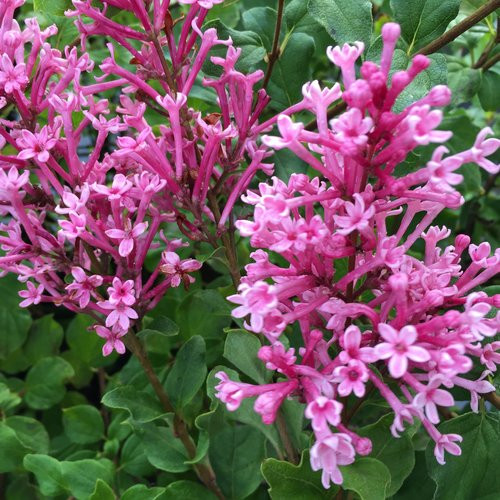| Syringa x pubescens 'SMNSPTP' | USDA Zone: 3-7 |
Get ready to debate! Are the flowers on Bloomerang Purpink® a lovely shade purple or are they pale pink? We couldn’t decide, so we combined them in the name to let you decide. The real conversation starts when you see just how many blooms it puts out in the spring and again later on in the summer. It’s one of the most prolific rebloomers in our series, which is saying something! It belongs in a highly visible spot in your garden, like near a front door or by your driveway.
Why grow Bloomerang Purpink® lilac?
- Unique coloring starts conversations and encourages multiple visits to the garden
- Incredible rebloom
- Reliable disease resistance
Bloom Time: Spring, Summer, Fall
Fragrant Flower
Continuous Bloom or Rebloomer
Disease Resistant
Fall Interest
Attracts: Butterflies, Bee Friendly
Common Name: Lilac
|
Key Feature
|
Light Needs | Landscape Uses |
 |
 |
|
|
|
|
| More About Bloomerang Purpink Reblooming Lilac |
| Height: 3-5 ft |
Spread: 3 ft |
Flower Colour: Pink / Purple Shades |
|
Plant only in full sun and well-drained soil; lilacs cannot tolerate soggy, wet conditions. The rebloom of Bloomerang lilac occurs on the new growth the plant creates after its spring bloom. For the best rebloom, it's vital that the plant grows vigorously during late spring and early summer. Do this by keeping it well-watered and mulched and in plenty of sun (six hours a day at least). If you wish to fertilize it, you may do so in early spring, once the ground has thawed, and again in late spring, after it blooms. If you want to prune Bloomerang lilac, do so immediately after its spring bloom. Never cut it back in fall, winter, or early spring - doing so will remove the spring flower buds. It is not necessary to prune Bloomerang lilac in order for it to rebloom. However, giving it a light trim after blooming does remove the developing seed heads (they look like green bananas, and some people don't care for the way they look on the plant), providing a neater look, and encourages more new growth for reblooming. Trimming after blooming will delay the rebloom by a few weeks compared to an untrimmed Bloomerang lilac. Note that when grown in a container, it may not perform exactly as indicated on the tag - this is to be expected. Also note that when growing plants in outdoor containers and baskets, they may require more frequent waterings than they would in the yard or garden. Be aware that in our climate, most plants cannot be expected to survive the winter if left in containers outdoors, and this plant is no exception. NOTE: Some flowers and plants may be harmful or poisonous to people or pets if touched or ingested. If you require more information before placing an order, please let us know in advance. |










